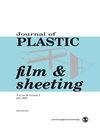Effects of Lithium bis(trifluoromethanesulfonyl)imide loading on thermal, mechanical and ion conducting properties of specialty interlayer films derived from scrap Polyvinyl butyral
IF 1.5
4区 材料科学
Q3 MATERIALS SCIENCE, COATINGS & FILMS
引用次数: 0
Abstract
This work investigates the feasibility of using scrap poly(vinyl butyral) (PVB) film derived from laminated glass factories as an ion-conductive interlayer film for producing electrochromic glass. The process uses PVB films made from masterbatches containing 10 to 60 wt% lithium bis(trifluoromethane sulfonyl)imide (LiTFSI). The investigation focused on how LiTFSI loading affected both the PVB masterbatches and the final PVB films. Higher LiTFSI loading correlated with increased ionic conductivity. The best electrochromic devices are obtained when the PVB films are directly prepared from the masterbatch without additional PVB flakes dilution during extrusion. The highest ionic conductivity 2.72 × 10双(三氟甲磺酰基)亚胺锂负载对废聚乙烯醇缩丁醛特种层间膜的热性能、机械性能和离子导电性能的影响
这项研究探讨了将从夹层玻璃工厂提取的聚乙烯醇缩丁醛(PVB)废料薄膜用作生产电致变色玻璃的离子导电中间膜的可行性。该工艺使用含 10 至 60 wt% 双(三氟甲烷磺酰)亚胺锂(LiTFSI)母料制成的 PVB 薄膜。调查的重点是锂双(三氟甲磺酰亚胺)含量对 PVB 母料和最终 PVB 薄膜的影响。LiTFSI 含量越高,离子传导性越强。如果 PVB 薄膜是直接从母料制备的,在挤出过程中无需额外稀释 PVB 片材,则可获得最佳的电致变色装置。含有纯 PVB 和含 60 wt% LiTFSI 的废 PVB 片的母料可获得最高的离子电导率 2.72 × 10-4 S/cm。此外,LiTFSI 还可作为 PVB 的增塑剂,降低玻璃化转变温度,增加 PVB 薄膜的百分比伸长率。
本文章由计算机程序翻译,如有差异,请以英文原文为准。
求助全文
约1分钟内获得全文
求助全文
来源期刊

Journal of Plastic Film & Sheeting
工程技术-材料科学:膜
CiteScore
6.00
自引率
16.10%
发文量
33
审稿时长
>12 weeks
期刊介绍:
The Journal of Plastic Film and Sheeting improves communication concerning plastic film and sheeting with major emphasis on the propogation of knowledge which will serve to advance the science and technology of these products and thus better serve industry and the ultimate consumer. The journal reports on the wide variety of advances that are rapidly taking place in the technology of plastic film and sheeting. This journal is a member of the Committee on Publication Ethics (COPE).
 求助内容:
求助内容: 应助结果提醒方式:
应助结果提醒方式:


